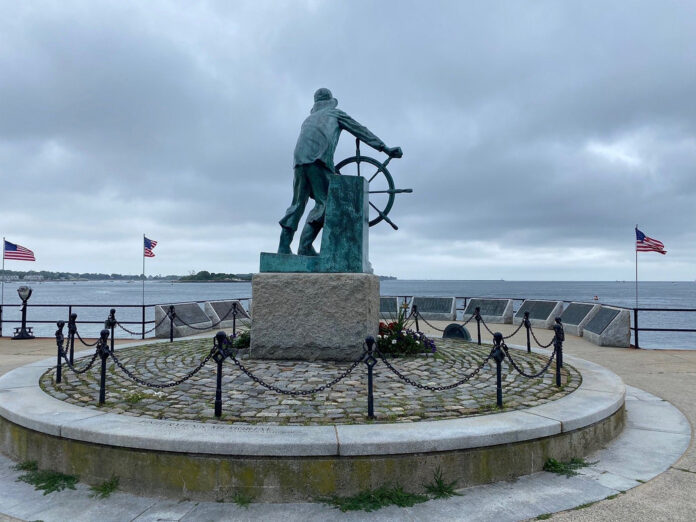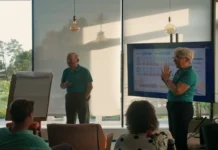
By Jim Clark
Perhaps it was just Irish kindness, perhaps it was the mystic influence of Jerome Connor (1874-1943), the sculptor born in Annascaul, or perhaps it was just meant to be! A year ago, I arrived in Annascaul and was standing in the Tom Crean Memorial Garden before the annual endurance walk held in honour of that heroic Antarctic explorer. I chanced there to meet a humble but charismatic Irish postman, and we shared our mutual admiration for the intrepid character, personality, and fortitude that made Tom Crean a memorable and irresistible legend.
When Jimmy Hogan described his work as a rural postie in Araglin, Co Cork it made me fondly recall my childhood during a simpler time in America. Jimmy knew and cared for each dog, person, and family along his route, while by contrast I have never even met the postman delivering to my home just north of Boston in Gloucester, Massachusetts. Jimmy took me to the Crean family grave, and he thought he saw a tear in my eye when I mentioned that Crean had lost a four-year-old daughter named Kate, the same name as my own granddaughter.
Changing the subject, I then told my new friend about Howard Blackburn, a Gloucester man who could perhaps match the impregnable endurance of Tom Crean. Thus began a year-long odyssey; starting in Annascaul and crossing your Western Ocean to revive the memory of an American sculptor and restore one of his dramatic creations that had been all but forgotten.
HOWARD BLACKBURN – LEGENDARY FISHERMAN AND LONE VOYAGER
Howard Blackburn (1859-1932) was born in Nova Scotia, but was dory fishing for halibut out of Gloucester when in 1883 he was caught by a winter storm off Burgeo Bank. His dory mate soon froze to death. Blackburn lost his mittens while bailing, but clenched his fingers around the oars so that he could continue to row for survival, as frostbite hardened his hands into claws of solid ice.
He rowed four days without food or water until landfall in Newfoundland, then after yet another day he finally reached an impoverished fishing family. Blackburn soon lost all his frozen fingers and half of each thumb.
After nearly three months of recovering in primitive and spartan conditions, he began a lengthy passage to the United States. Blackburn returned to Gloucester, renowned for his endurance and unbelievable story of survival at sea. He became a successful publican like Tom Crean and was impaired more by our acceptance of prohibition than by his handicap.
Blackburn subsequently sailed twice single-handed across the Atlantic (1899 and 1901), notable accomplishments for any man, but uniquely challenging without fingers or the manual dexterity normally required at sea.
I sent postman Hogan a biography of Howard Blackburn along with photographs of his grave in Gloucester and his vessel, ‘Great Republic’, now displayed in the Cape Ann Museum. In the Museum records, I happened to notice that a portrait bust sculpture of Blackburn had been made by Leonard Craske, the creator of Gloucester’s most famous monument, the ‘Fishermen’s Memorial’.
LEONARD CRASKE – SCULPTOR, NOW FADING FROM MEMORY
After “Googling” ‘Leonard Craske’, I was dismayed to learn that there was practically no information presented about his life. 2023 is the 400th anniversary of Gloucester, and it seemed only appropriate to again remember Leonard Craske because his ‘Fishermen’s Memorial’ is beloved in Gloucester and recognised throughout our country. My research soon developed to reveal the remarkable life and accomplishments of Craske, which is published as a Gloucester400 chapter and can be viewed online: http://www.gloucesterma400.org/wp-content/uploads/g400-stories-craske-fin-web.pdf.
Leonard Craske was born in England (1878) and was an outstanding student until he left medical school to become a professional stage actor. He travelled to the U.S. with British theatrical companies for a few years, then in 1913 moved to New York to perform on stage and in very early moving pictures. In 1916, he relocated to Boston working as an actor in repertory company at the Copley Theatre. Craske soon established a studio in Boston to pursue his interests in sculpture and photography, and by 1920 he retired from acting to become a professional sculptor. He established a second studio in nearby Gloucester, become a permanent summer resident, and was soon a celebrity within the artistic community.
In 1923, Craske won an open competition to create a memorial for the fishermen of Gloucester as part of the 300th anniversary of America’s oldest seaport. Although the ‘Fishermen’s Memorial’ was not actually unveiled until 1925, it soon became widely recognised as a symbol of Gloucester and our intrepid fishermen. Craske created only a few other significant monuments before the Great Depression eliminated virtually all demand for monumental sculpture.
He survived the lean years of the 1930s by presenting lectures, narrated with an impressively dramatic stage presence and illustrated by colour lantern slides and colour moving pictures in an era when they were not yet common.
BLACKBURN MEMORIAL ‘REDISCOVERED’ AND RESTORED
In 1932, Craske modelled a portrait bust just before Howard Blackburn died, and then he created a plaster cast model entitled ‘Memorial to Howard Blackburn’. These sculptures were donated to the Gloucester Fishermen’s Institute in 1950 by bequests from Craske’s will. At the demise of the Institute in 1983, the bust was acquired and displayed in Gloucester’s Sawyer Free Library, but the ‘Memorial’ was damaged and disappeared from public view.
Further research finally located the ‘Memorial’ in a storage vault of the Cape Ann Museum. The endurance of a Blackburn or Crean was required to persevere through museum bureaucracy and even view the sculpture to determine if it could be restored. After several months I was finally permitted to see the plaster ‘Memorial’, and Gloucester400 immediately determined that it should be restored during this anniversary year as a tribute to both Craske and Blackburn. This restoration was performed by the sculptor Robert Shure and his associates at the Caproni Collection.
Remarkably, the present Caproni Collection is directly descendant from the firm that originally made the plaster foundry pattern for the famous ‘Fisherman’s Memorial’ one hundred years ago. Quite probably, Caproni also made this plaster ‘Memorial to Howard Blackburn’, but documentation was unfortunately lost during a fire in the 1950s. The Gloucester400 website will also soon release a video depicting restoration of this historic sculpture.
THAT CHANCE ENCOUNTER
During our present century, Ireland has remembered and respectfully honoured Tom Crean, the son of Annascaul. Generations of Irish spirit have crossed to New England, and it is pleasing to now report that a fortuitous chance connection in Ireland has renewed appreciation within Gloucester for memories fading from our own local memory. This good fortune may be a simple result of Irish kindness, but I am honoured to have found a new friend and Gloucester400 extends its gratitude to Jimmy Hogan, a postman and soul of Araglin, Co Cork.









